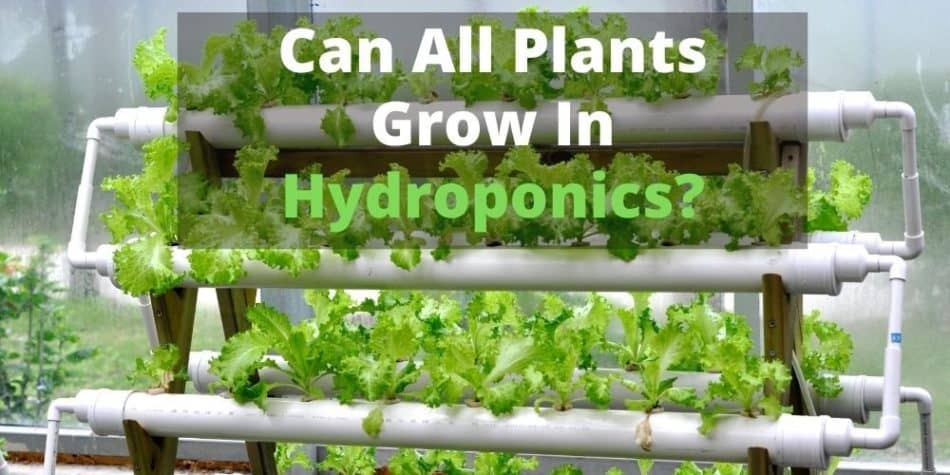Hydroponic gardening has become more popular as people are looking to grow their own produce. The huge benefits to hydroponic gardening compared to soil is the water efficiency, control over growing conditions, shorter grow times, and higher yields.
Given the convenience and benefits of hydroponics, people start wondering what plants can even grow in hydroponics. After all if its so much better then why isn’t all of our food grown hydroponically instead of the soil?
Any plant can be grown in a hydroponic system that can grow in soil. However, there are plants that are not recommend to be grown in hydroponic systems for a few reasons. As a rule of thumb, plants that are tall, wide, or grow with vines are not recommended for hydroponics. All of these plants take up a lot of space that can be better utilized for smaller vegetables that have shorter crop cycles.
Here is a video that walks through this rule of thumb. You can see which plants do well in hydroponics versus the plants that are better suited to grow in soil.
What Plants Can Be Grown Hydroponically?
Any plant can be grown hydroponically but it depends on the hydroponic system and the plant type.
For example, you do not want to grow large plants in an Nutrient Film Technique (NFT) system since the roots will clog the water channels. In the NFT system below you can see that herbs and leafy greens are being grown. If you choose a bigger plant that has a longer crop cycle such as a tomato then the water channels can get blocked from the tomato’s roots.
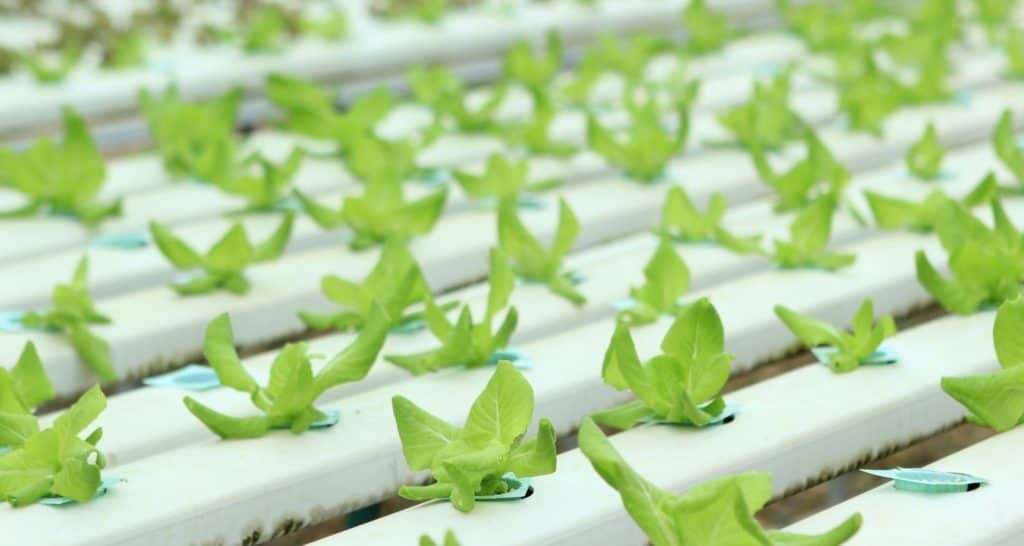
However, tomatoes are commonly grown hydroponically using the Deep Water Culture (DWC) or Kratky method. These hydroponic setups allow plants to grow over a longer period of time since these systems do not have water channels. The plants sit in the water reservoirs so plants are encouraged to get as large as they want without causing issues in these systems.
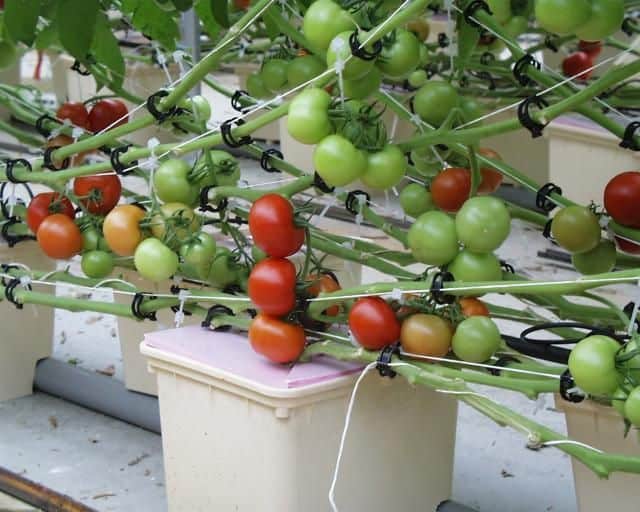
Checkout this article for a deeper look at how each hydroponic method works and the plants that grow best in each system. Remember you CAN grow any plant hydroponically and in any system. But you probably SHOULD NOT grow certain plants in specific hydroponic systems based on the rule of thumb we mentioned earlier.
What Plants Grow In Each Of The Hydroponic Systems?
Let’s briefly cover the different hydroponic systems so we can see which plants do better in each system. It is possible to setup multiple hydroponic systems especially since some systems require little cost and equipment.
You are not required to use only one hydroponic system or grow only the plants that are recommended. But this guide should help you decide which system(s) you want to setup to grow the plant(s) you want.
Nutrient Film Technique (NFT)
Nutrient Film Technique or NFT systems use water pumped through water channels in order to grow the plants. Commercial setups such as the one seen below use rows of these water channels to grow a lot of leafy greens at the same time.
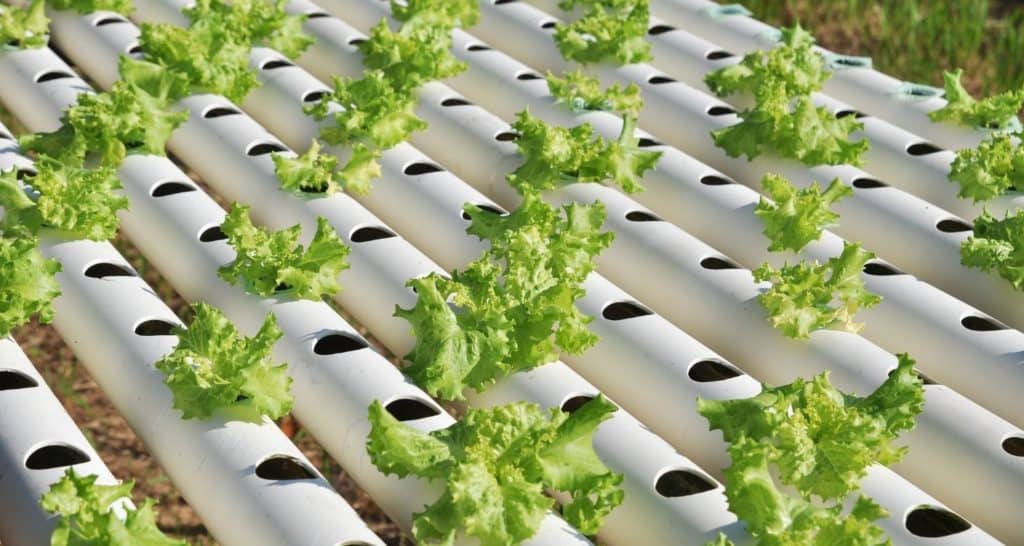
You can also set this up for a home grown where the pipes are stacked vertically to make use of vertical space better. However, the idea is the same – nutrient rich water gets pumped into water channels. The plants sit on top of these water channels and drink and eat from their roots as the water flows by.
The best plants for NFT systems are ones that have short crop cycles and have shallow roots. Big roots can clog the pipes which means this system does not do well for larger plants such as tomatoes.
Recommended plants for NFT systems:
- Lettuces
- Kale
- Spinach
- Brocolli
- Bok Choy
- Chard
- Herbs such as basil, cilantro, and dill
- Strawberries
- Anything with a short crop cycle that has shallow roots
Deep Water Culture (DWC)
Deep Water Culture or DWC is where a plant sit on top of a water reservoir that has an air stone pumping oxygen into the water.
The plant simply sit on top of the water reservoir, such as a bucket, and continues to eat and drink until it’s ready to harvest. The water reservoir must be refilled if it gets too low before the plant is finished growing.
For commercial or larger growing operations, it’s common to see floating styrofoam sheets that hold the plants at water level. This way the plants roots will always be submerged in the water regardless of the water level.
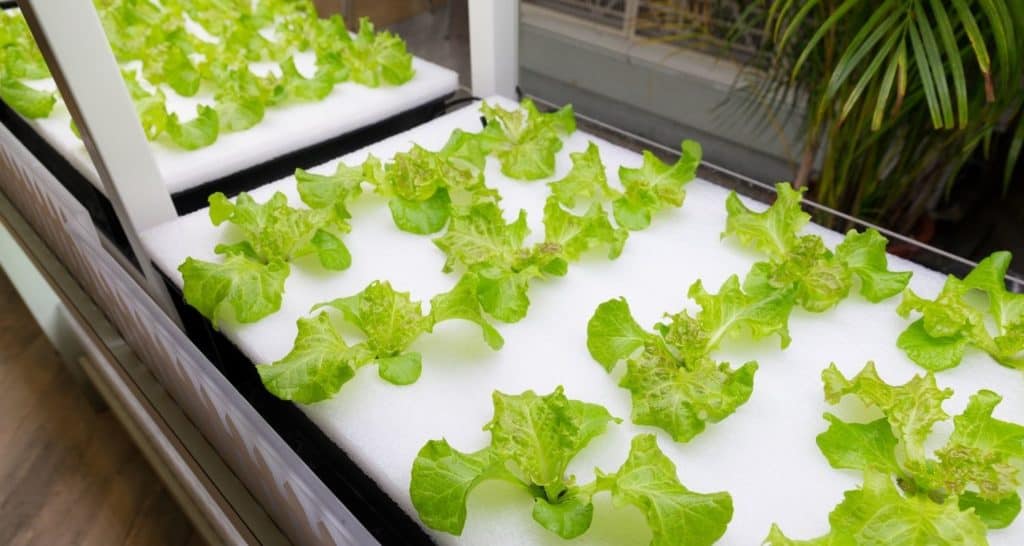
You can grow plants with longer crop cycles as opposed to NFT since you do not have to worry about roots clogging any pipes in this hydroponic system. However, you do need to keep in mind that taller plants can fall over in this system if they’re not supported.
Recommended plants for DWC systems:
- Lettuces
- Kale
- Spinach
- Okra
- Brocolli
- Bok Choy
- Chard
- Herbs such as basil, cilantro, and dill
- Strawberries
- Anything that does not grow to be very tall (unless you add supports)
Ebb and Flow
Ebb and Flow, also known as Flood and Drain, is where the plants sit in a large tray full of growing medium. The tray is periodically flooded so the plants can be “watered” and then the tray is drained so the plants can get the oxygen they need from the air.
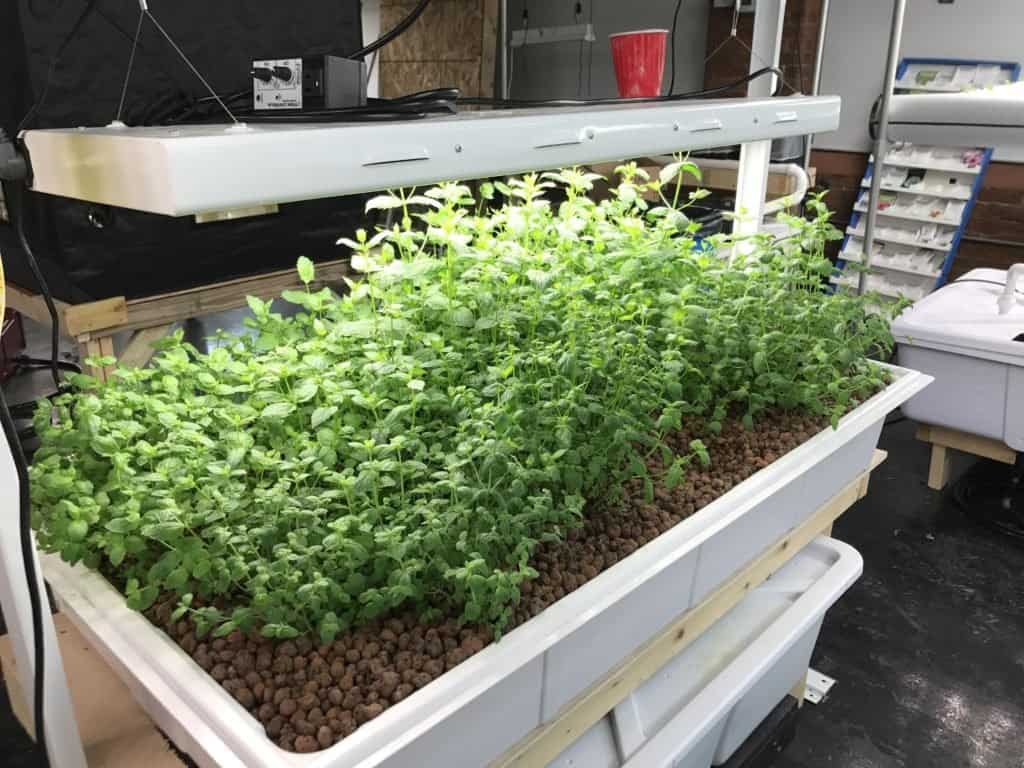
The growing medium can be as deep as the tray so the plant’s roots will have something to hold onto as the plant grows taller. This means you can grow plants such as tomatoes that are on the taller side before they are ready to be harvested.
Recommended plants for Ebb and Flow systems:
- Lettuces
- Kale
- Spinach
- Okra
- Brocolli
- Bok Choy
- Chard
- Herbs such as basil, cilantro, and dill
- Strawberries
- Cucumbers
- Tomatoes
- Anything really! If there is enough growing medium to hold the plant upright then you can grow it in this system
Aeroponics
Aeroponics is where the plants roots are suspended in the air but there are misters or sprayers that frequently spray the roots to keep them moist. This method is often seen as the most complex as this is what NASA uses to grow plants in space.
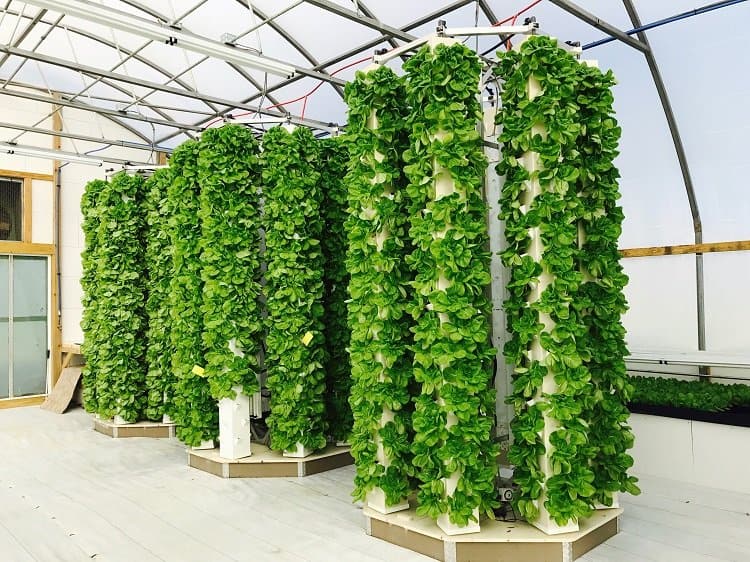
The huge benefit to this system is that it is the most water efficient and plants typically grow the fastest. However, this method is also the easiest to have catastrophic failures since a clogged mister or faulty water pump can kill your entire crop. Since the roots are exposed to air, any long periods of dry air will damage or kill the plant.
In concept, you can grow any plant in aeroponics. However, depending on your aeroponics setup you might be limited to just shorter plants since the plant’s roots are dangling in the air. This means the plant’s roots will not be able to grab onto anything for support.
Recommended plants for Aeroponic systems:
- Lettuces
- Kale
- Spinach
- Okra
- Brocolli
- Bok Choy
- Chard
- Herbs such as basil, cilantro, and dill
- Strawberries
- Anything that does not grow to be very tall (unless you add supports)
Aquaponics
Aquaponics is a combination of growing vegetables and fish and creating a mini ecosystem. Unlike hydroponics where you need to add nutrient solutions to the water, aquaponics can be completely self-sufficient and organic.
The only substance that needs to get added to this system is fish food. However, it’s common to add other nutrients to this ecosystem if there are any deficiencies.

One the nice benefits to aquaponics is that you will not only have vegetables to harvest but also fish. If you don’t want to eat any of your fish then you can get ornamental fish such as goldfish or angelfish instead and focus on the plants.
Aquaponics is similar to the Ebb and Flow system in the sense that the plants are growing in a tray filled with growing medium. So similar to the Ebb and Flow system, you can grow any plant but it depends on the depth of your growing medium.
Recommended plants for Aquaponic systems:
- Lettuces
- Kale
- Spinach
- Okra
- Brocolli
- Bok Choy
- Chard
- Herbs such as basil, cilantro, and dill
- Strawberries
- Cucumbers
- Tomatoes
- Anything really! If there is enough growing medium to hold the plant upright then you can grow it in this system
Kratky Method
The Kratky method, also known as the set it and forget it method, is similar to DWC where the plant sits on top of a water reservoir. Unlike the DWC, you cannot have your plants sitting on a styrofoam raft in the Kratky method.
Instead the plants must sit on top of a lid, such as a bucket lid, so that the roots get exposed to air as the water level declines. This is how the plants get their oxygen as they grow to maturity.
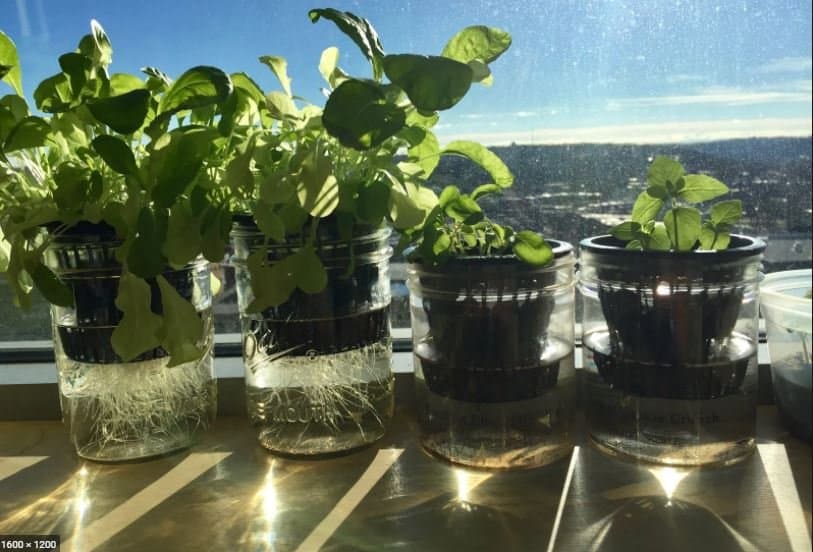
One of the main benefits to the Kratky method is how simple and cheap this system is. You just need to sit your plants on top of a water reservoir and let mother nature do the rest.
It’s common to see people use totes as growing trays, 5 gallon buckets for taller plants, and even mason jars for little herb and lettuce growing setups.
The one challenge with the Kratky method is if your water reservoir is too small for the plant(s) you are growing then you need to carefully refill the reservoir. However, you must not completely fill the reservoir back to the top otherwise the plant will drown. So filling the water reservoir to 1/2 to 2/3 of the way is recommended.
Recommended plants for Kraty method:
- Lettuces
- Kale
- Spinach
- Okra
- Brocolli
- Bok Choy
- Chard
- Herbs such as basil, cilantro, and dill
- Strawberries
- Cucumbers
- Tomatoes
- Anything really! If there is enough growing medium to hold the plant upright then you can grow it in this system
Wick System
The wick system is where the plants sit in a growing tray above the water reservoir and get the water they need through a wick. A wick that sits in the water reservoir will pull up water from the reservoir to the plant’s roots due to capillary action. This is how the plants get the water they need to survive.
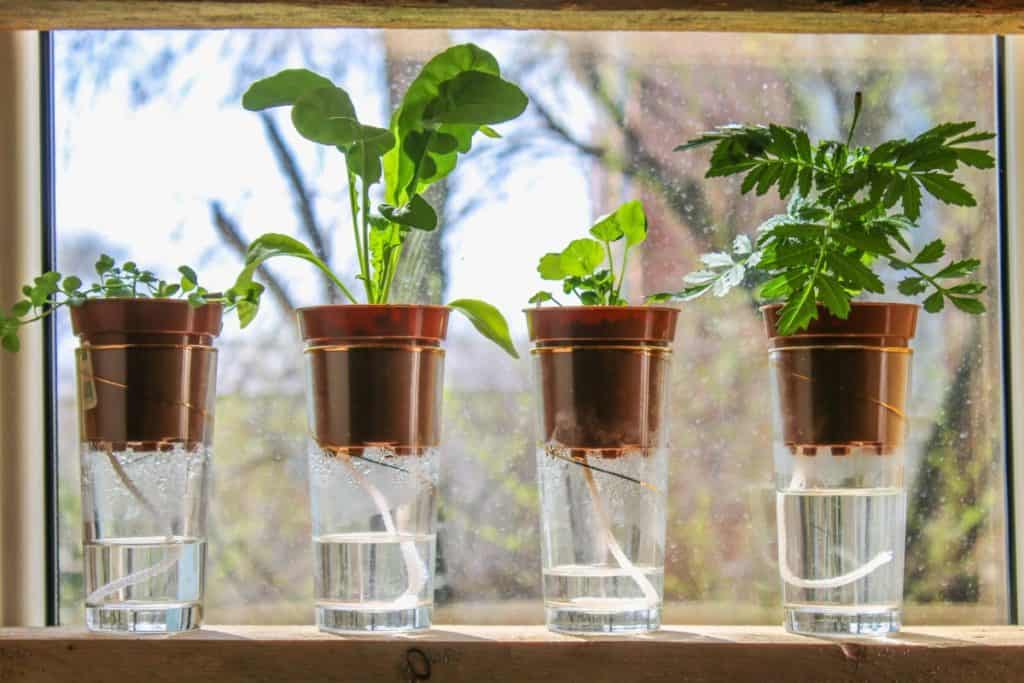
You can have multiple plants in the same growing tray at different plant stages. Each plant will pull up and consume as much water as needed which makes this system great for growing trays for seedlings.
For plants that need more water such as tomatoes, the wick system is not ideal as the plant will not be able to get enough water through the wick. So smaller and lower water consumption plants are ideal.
Recommended plants for the Wick System:
- Lettuces
- Kale
- Spinach
- Okra
- Brocolli
- Bok Choy
- Chard
- Herbs such as basil, cilantro, and dill
- Strawberries
- Anything that does not consume a lot of water
Conclusion
Any plant can grow hydroponically. The real question to ask is should a specific plant be grown hydroponically. In some cases the answer is no since hydroponics is best used for shorter crop cycle plants that can be harvest and replaced with new ones.
Hydroponics are a great way to grow smaller vegetables and fruits such as leafy greens and tomatoes. However, you shouldn’t be growing your apple tree hydroponically anytime soon.

